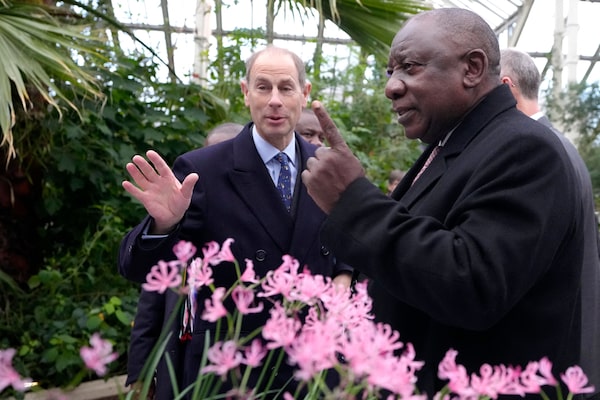If you’re reading this on the web or someone forwarded this e-mail newsletter to you, you can sign up for Globe Climate and all Globe newsletters here.
Good afternoon, and welcome to Globe Climate, a newsletter about climate change, environment and resources in Canada.
Did you read the most recent edition of Report on Business Magazine? Each publication features someone from the climate fight world, but this one has some great enviro reads, including our writeup on Corporate Citizen of the Year, Barbara Zvan who is at the vanguard of climate action with her work at University Pension Plan Ontario.
Also inside: At US$106.3 million in profit, can this Winnipeg-based packaging company make money and stay onside with ESG concerns? And read about how GHGSat tracks gas emissions from space to help mitigate climate change.
Now, let’s catch you up on other news.
Noteworthy reporting this week:
- Hot take: Time to kill off the big, fat COP climate conferences that accomplish almost nothing
- Policy: Newfoundland, Nova Scotia, PEI to start paying federal carbon tax
- Wildlife: The 20-year campaign to protect the endangered fish found on only one place on Earth
- In-depth read: Solar Panda looks to bring power to African countries in need of affordable electricity
- Art: David Suzuki isn’t going anywhere, even after retiring from his CBC series The Nature of Things.
- Mining: Barrick Gold faces Ontario lawsuit for alleged killings and abuses at Tanzanian mine
- Investigation from The Narwhal: The federal government is less likely to protect an at-risk fish if people like to eat it
A deeper dive
Resilience and adaptation is key
Sierra Bein is the author of Globe Climate. For this week’s deeper dive, she collects our reporting on climate adaptation in Canada.
Canada’s first National Adaptation Strategy was finally released, but falls short of the ambition initially promised from Ottawa two years ago as a comprehensive roadmap to counter climate change-related disasters and emergencies expected in the future.
The plan was initially touted as a way to give Canada a chance to lead, in some regards. If taken as a work-in-progress, which is how the government is framing it, the strategy has some promise as a belated start in setting clear targets for resilience-building and implementing corresponding measures.
However, we’ve already been waiting for this, the federal government promised that by the end of this year, it will release these plans. But more than just Ottawa cobbling together a plan, its development was supposed to bring together provinces, communities, the private sector and other partners in common purpose.
As Adam Radwanski wrote, it was a very complex undertaking for under one year. The effort should have started sooner to transform the country, and there was a lot of grappling with fundamental questions about what this sort of strategy even looks like. But, keep in mind too, how difficult it is to set concrete targets for something not easily quantifiable.
But at $1.6-billion in new federal investments, even taking into account approximately $8-billion in pre-existing federal climate-adaptation commitments, the money is nowhere near what will likely ultimately be needed as different regions of the country face a growing array of potentially devastating climate-change consequences.
Early this year, our climate team took to task to envision what resilience innovation could look like. We tackled health, agriculture, nature and conservation, and flooding, using our imaginations to think of what a more climate-resilient Canada could look like.
Read more climate adaptation storytelling from The Globe:
B.C.’s Highway 8: Nancy MacDonald wrote about Highway 8, also known as the Nicola Highway, and the lives that were affected after an atmospheric river dumped a month’s worth of rain on the region over a span of two days. But fast forward to today after the floods and the fires and the government support, many who live along it are still struggling to rebuild.
Canada’s disaster aid system is overwhelmed: For more than 50 years, homeowners and businesses hit by fires, floods or storms have had a federal program to help governments decide who pays for the cleanup. Now, victims are often being left to rebuild on their own as climate change is exposing its weaknesses and renewing talk of big changes to come.
Flood management: Conservation authorities responsible for flood management are losing their say in Ontario’s land development. Building on river floodplains has proven costly and devastating to Canadians, and a new Globe analysis reveals which cities are most at risk.
What else you missed
- Canada’s top five federal contaminated sites to cost taxpayers $4.38-billion to clean up
- Giant trees still fall amid old-growth funding lag for B.C. First Nations
- Activists aggravate art insurers’ climate headache
- Wildlife conference boosts protection for sharks, turtles
- Europe’s heatwave may have caused more than 20,000 ‘excess’ deaths
- How a beetle wiped out hundreds of thousands of ash trees in Canada’s urban forests
- Record-setting Ontario storm drops over a metre of snow, strong winds were forecasted
- Putin touts Russia’s ‘Arctic power’ with launch of nuclear-powered icebreakers
- U.S. aims to sanction Brazil deforesters, adding bite to climate fight
Opinion and analysis
Julie Segal: We can still keep the planet’s warming below 1.5 degrees, but we must act now
David Knight Legg: Why does Canada keep missing its climate targets?
Laurent Ramsey: Investors need to recognize the economy’s most valuable asset: nature
Robyn Urback: When it comes to dumb protests, there is such a thing as bad press
The editorial board: A year after the last big flood, B.C. isn’t ready for the next one
Eric Bosco and Annie Levasseur: Ignoring climate change is becoming really, really expensive
Kelly Cryderman: Paris climate agreement Article 6 idea back in play
Green Investing
Stress test brings you climate content
Have you heard Stress Test yet? If not, join The Globe and Mail’s personal finance team, columnist Rob Carrick and editor Roma Luciw, as they guide you through one of the biggest stress tests your finances will ever face. Recently, they’ve explored how to balance green or ethical investing with making money, and talked about if electric vehicles are an affordable solution to soaring gas prices.
- How this money manager takes a ‘pragmatic’ approach to ESG investing
- B.C. added two tax credits, including the Climate Action Tax Credit
Making waves
Each week The Globe will profile a Canadian making a difference. This week we’re highlighting the work of Elisha Battick blogging about climate change adaptation and mitigation.

Elisha BattickSupplied
I’m Elisha Battick, 23, from Winnipeg. I’m studying computer science at the University of Manitoba, and considering an environmental science minor.
I started my blog Tenacious Thinker at the end of 2019. It has since taken shape as a space to explore topics of wellness and sustainability. There, I can work through and share ideas about caring for ourselves, others and the environment.
One of my favourite concepts I’ve written about on Tenacious Thinker is ‘eco-minimalism.
Eco-minimalism is an approach to minimize environmental impact while maximizing human well-being and economic benefit. As a design concept, it prioritizes simple, low-tech solutions which is a big part of balancing climate change adaptation and mitigation. Adopting this concept to the way we live addresses both wellness and sustainability. Incorporating eco-minimalism into how we design our life holds potential for addressing pressing sustainability issues.
- Elisha
Do you know an engaged individual? Someone who represents the real engines pursuing change in the country? Email us at GlobeClimate@globeandmail.com to tell us about them.
Photo of the week

South Africa's President Cyril Ramaphosa and Britain's Prince Edward, Earl of Wessex tour the Temporate House at the Royal Botanic Gardens in Kew, southwest London, on November 23, 2022 on the second day of his two-day state visit. Ramaphosa urged rich nations to help save vulnerable ones from climate change, as he made the first state visit of King Charles III's reign.KIRSTY WIGGLESWORTH/AFP/Getty Images
Catch up on Globe Climate
- The COP27 1.5-degree goal still shows signs of life... for now
- COP27 winding down, plus meet our new environment reporter
- A vibe check at COP27 in Egypt
- A postcard from Alberta’s Energy Transition Corridor road trip
We want to hear from you. Email us: GlobeClimate@globeandmail.com. Do you know someone who needs this newsletter? Send them to our Newsletters page.